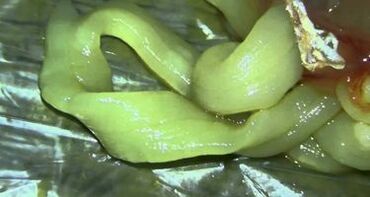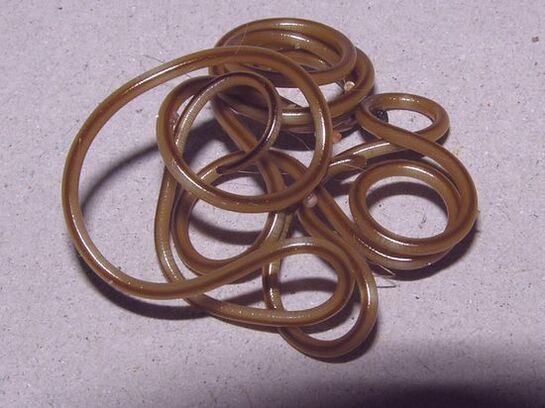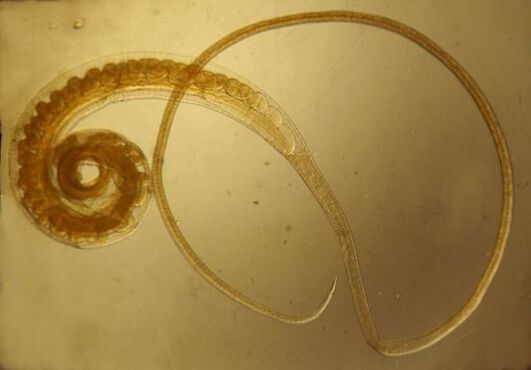
Living in this world is healthy-parasites in the body can interfere with this. These are lower plant and animal forms, living at the expense of the owner. Translated from Greek, they mean-greedy ghost.
By parasitic means, they can be external and internal.
Parasites in the human body are divided into flatworms and roundworms.
Flat ones are divided into flukes and cysts.
Roundworms are also called nematodes.
Nematodes that live in the human body

What parasites live in the body, first of all are nematodes-they grow very long and have the shape of an earthworm, hence the name-roundworms, they are:
- roundworms;
- Pinworm;
- hookworm;
- Trichinella.
roundworms
One of the most common nematodes is a parasite, which in some cases can reach 45 cm in length. The female produces 200, 000 eggs, and this process occurs regardless of whether there is a male in the host. Eggs fall into the ground together with feces, and when favorable factors appear, they become larvae. You can get this worm through dirty hands and unwashed vegetables, fruits, and berries.
Signs of infection: nausea, salivation, loss of appetite. When a large number of roundworms are present, serious consequences may occur. After the suture breaks, pancreatitis occurs. Roundworms are especially dangerous for pregnant women-they can invade the fetus.
Pinworm
Small worms up to 10 mm in size are mainly infected by children and are more common in kindergartens. People who are sick become the cause of infection. If you do not follow personal hygiene rules, the possibility of infection will increase greatly. Signs of worms:
- Itching at night in the anal area;
- Performance degradation;
- sleep disorder;
- Nervous disorders.
The presence of pinworms does not threaten the lives of patients, but it is very unpleasant and leads to ecological disorders.
hookworm
The 20 mm parasite is pink and has less performance, but its harm is huge. He has teeth and dental plates in his mouth to bite off blood vessels. The larvae penetrate the body through the skin of barefoot walkers.
The main task of the larvae is to enter the human mouth. When swallowing saliva, they descend from there to the intestines, where they excrete adult worms. They feed on human blood and cause anemia. The threat is caused by their waste, which poisons the body. The signs of the presence of worms are: persistent bronchitis, dermatitis, nausea, abdominal pain, and indigestion. The heart suffers from this parasite-myocarditis may occur.
Trichinella
The females of worms can reach up to 4 mm, and the males are smaller. They die in the external environment and only survive in the body. The source of infection is undercooked animal meat. Parasites distribute in various organs through blood vessels, take root and sprout, and can live for 20 years.

The most common signs of infection are:
- Increased blood tests for eosinophils;
- The temperature rises to 40°C;
- Muscle pain;
- Conjunctivitis and facial swelling.
Fluke parasites
The worm is small, flat, and has 2 suction cups on it. Most of them are hermaphrodite. Development requires an intermediate host.
fluke
Worms-hermaphrodite, grow to 14 mm, affecting the bile ducts. After the eggs enter the water body, they settle in mollusks, where they develop into larvae, and then the larvae attach to the scales of the fish. If a person eats poorly fried fish at this time, he may be infected with this parasite.
In the body of its ultimate host, humans, flukes are introduced into the duodenum, where the larvae grow into adults. People who consume fish products and work on water containers (their waste seeps into the water) can infect water bodies.
Schistosoma
Worms, with heterosexual individuals, look like needles. A pair of parasites produces as many as 3000 eggs in 24 hours. A person can become infected while bathing or using contaminated water. In the lungs and blood vessels, the larvae become adults. After this, spawning occurs in the intestine.
In the presence of schistosomes, the following conditions have been observed:
- stomach ache;
- Violation of appetite;
- anemia;
- Change from diarrhea to constipation;
- lose weight;
- Violation of the female cycle;
- Male impotence;
- Children’s academic performance declines.
When nerve fibers are introduced, it is possible to develop paralysis and brain damage.
Where can worms settle
People are often interested in where the parasite lives in the human body?
The positioning is due to the type of host that enters the "parasite". More commonly, they settle in the digestive organs, lungs, heart, and liver.
The human body where the parasites live becomes weak and begins to suffer from various diseases, so it is not difficult at all to determine if there are parasites in the body. You just need to pay more attention to yourself. If you have the slightest suspicion, you can't postpone your visit to the doctor.

In order for the body where the 6-letter parasite is to heal and become healthy, it must abide by the rules of hygiene, not drinking raw water, and not eating cooked meat. Only in this way can the risk of infection be reduced.
It's great to live in this world, you don't want to think about parasites in the human body, but you have to. After all, everyone on the planet is infected with worms. The organism in which the parasite lives is a field of miracles, and it will happen. But believe that fate is the fate of the weak.



























